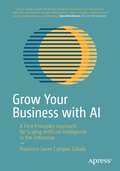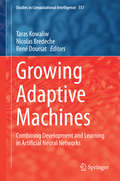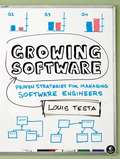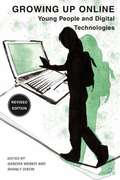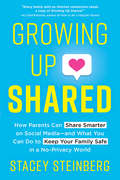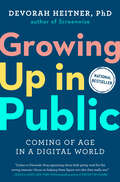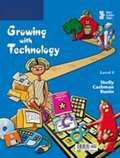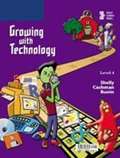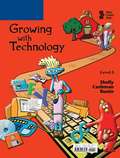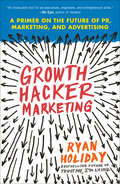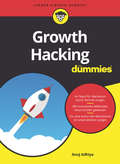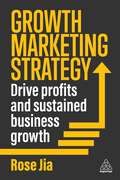- Table View
- List View
Grow Your Business with AI: A First Principles Approach for Scaling Artificial Intelligence in the Enterprise
by Francisco Javier Campos ZabalaLeverage the power of Artificial Intelligence (AI) to drive the growth and success of your organization. This book thoroughly explores the reasons why it is so hard to implement AI, and highlights the need to reconcile the motivations and goals of two very different groups of people, business-minded and technical-minded. Divided into four main parts (First Principles, The Why, The What, The How), you'll review case studies and examples from companies that have successfully implemented AI. Part 1 provides a comprehensive overview of the First Principles approach and its basic conventions. Part 2 provides an in-depth look at the current state of AI and why it is increasingly important to businesses of all sizes. Part 3 delves into the key concepts and technologies of AI. Part 4 shares practical guidance and actionable steps for businesses looking to implement AI. Grow Your Business with AI is a must-read for anyone looking to understand and harness the power of AI for business growth and to stay ahead of the curve. What You'll LearnReview the key concepts and technologies of AI, including machine learning, natural language processing, and computer visionApply the benefits of AI, including increased efficiency, improved decision-making, and new revenue streams in different industriesIntegrate AI into existing systems and processes.Who This Book Is ForEntrepreneurs, business leaders, and professionals looking to leverage the power of AI to drive growth and success for their organizations.
Growing Adaptive Machines
by Taras Kowaliw Nicolas Bredeche René DoursatThe pursuit of artificial intelligence has been a highly active domain of research for decades, yielding exciting scientific insights and productive new technologies. In terms of generating intelligence, however, this pursuit has yielded only limited success. This book explores the hypothesis that adaptive growth is a means of moving forward. By emulating the biological process of development, we can incorporate desirable characteristics of natural neural systems into engineered designs and thus move closer towards the creation of brain-like systems. The particular focus is on how to design artificial neural networks for engineering tasks. The book consists of contributions from 18 researchers, ranging from detailed reviews of recent domains by senior scientists, to exciting new contributions representing the state of the art in machine learning research. The book begins with broad overviews of artificial neurogenesis and bio-inspired machine learning, suitable both as an introduction to the domains and as a reference for experts. Several contributions provide perspectives and future hypotheses on recent highly successful trains of research, including deep learning, the Hyper NEAT model of developmental neural network design, and a simulation of the visual cortex. Other contributions cover recent advances in the design of bio-inspired artificial neural networks, including the creation of machines for classification, the behavioural control of virtual agents, the desi gn of virtual multi-component robots and morphologies and the creation of flexible intelligence. Throughout, the contributors share their vast expertise on the means and benefits of creating brain-like machines. This book is appropriate for advanced students and practitioners of artificial intelligence and machine learning.
Growing Software: Proven Strategies for Managing Software Engineers
by Louis Testa<P>As the technology leader at a small software company, you need to focus on people, products, processes, and technology as you bring your software to market, while doing your best to put out fires and minimize headaches. <P>Growing Software is your guide to juggling the day-to-day challenges of running a software company while managing those long-term problems and making sure that your business continues to grow. With practical, hands-on advice, Growing Software will teach you how to build and lead an effective team, define and sell your products, work with everyone from customers to CEOs, and ensure high-quality results.Instead of learning by trial and error, you'll benefit from author Louis Testa's 20+ years of management experience. Testa combines big-picture advice, specific solutions, and real-life anecdotes to teach you how to: <br>–Work effectively with your CEO and executive team <br>–Improve development team efficiency and enthusiasm <br>–Evaluate your software methodology to improve effectiveness and safeguard against failure <br>–Use product prototypes to bridge the gap between marketing and engineering <br>–Defuse technology time bombs <P>Whether you're new to managing software or newly lost, Growing Software will help you and your growing company thrive.
Growing Up Online
by Sandra Weber Shanly DixonIn this cutting-edge anthology, contributors examine the diverse ways in which girls and young womenacross a variety of ethnic, socio-economic, and nationalbackgroundsare incorporating and making sense of digital technology in their everyday lives. Contributors explore identity development, how young women interact with technology, and how race, class, and identity influence game play. "
Growing Up Shared: How Parents Can Share Smarter on Social Media-and What You Can Do to Keep Your Family Safe in a No-Privacy World
by Stacey SteinbergIs it okay to share details about my child's life on social media?What kinds of pictures should I avoid posting?Am I taking away my kids' ownership over their future online footprint?It has never been easier to share our lives online—from meals to selfies and relationship statuses to locations, information about our daily activities flows freely. But what about our right to share our kids' lives? In today's age of "sharenting", striking the right balance between engaging in online communities and respecting a child's privacy and safety can be difficult. In Growing Up Shared, Stacey Steinberg, law professor, mother, and expert on the intersection of social media and parenting, shares her insights. From her years of research, Steinberg outlines what parents should and should not feel comfortable sharing, while providing suggestions and ideas for a wide range of approaches, including:How we can benefit from sharing, and how screens can connect usThe dangers of oversharingHow to model behavior onlineThe difference in how parents and kids view online sharingThe importance of educating kids about technologyEngaging, approachable, and with concrete takeaways for today's parents, Growing Up Shared investigates the benefits and risks of sharing our kids' lives on social media, and will help any parent decide on the right path for their family to follow in the online world.
Growing Up With Technology: Young Children Learning in a Digital World
by Christine Stephen Lydia Plowman Joanna McPakeGrowing Up with Technology explores the role of technology in the everyday lives of three- and four-year-old children, presenting the implications for the children’s continuing learning and development. Children are growing up in a world where the internet, mobile phones and other forms of digital interaction are features of daily life. The authors have carefully observed children’s experiences at home and analysed the perspectives of parents, practitioners and the children themselves. This has enabled them to provide a nuanced account of the different ways in which technology can support or inhibit learning. Drawing on evidence from their research, the authors bring a fresh approach to these debates, based on establishing relationships with children, families and educators to get insights into practices, values and attitudes. A number of key questions are considered, including: Which technologies do young children encounter at home and preschool? What kind of learning takes place in these encounters? How can parents and practitioners support this learning? Are some children disadvantaged when it comes to learning with technology? Growing Up with Technology is strongly grounded in a series of research projects, providing new ways of thinking about how children’s learning with technology can be supported. It will be of great interest to undergraduate and postgraduate students on a range of courses including childhood studies, and those with a particular interest in the use of technology in education. Parents, practitioners and researchers will also find this a fascinating and informative read.
Growing Up in Public: Coming of Age in a Digital World
by Devorah HeitnerThe definitive book on helping kids navigate growing up in a world where nearly every moment of their lives can be shared and comparedNATIONAL BESTSELLER With social media and constant connection, the boundaries of privacy are stretched thin. Growing Up in Public shows parents how to help tweens and teens navigate boundaries, identity, privacy, and reputation in their digital world. We can track our kids&’ every move with apps, see their grades within minutes of being posted, and fixate on their digital footprint, anxious that a misstep could cause them to be &“canceled&” or even jeopardize their admission to college. And all of this adds pressure on kids who are coming of age immersed in social media platforms that emphasize &“personal brand,&” &“likes,&” and &“gotcha&” moments. How can they figure out who they really are with zero privacy and constant judgment? Devorah Heitner shows us that by focusing on character, not the threat of getting caught or exposed, we can support our kids to be authentically themselves. Drawing on her extensive work with parents and schools as well as hundreds of interviews with kids, parents, educators, clinicians, and scholars, Heitner offers strategies for parenting our kids in an always-connected world. With relatable stories and research-backed advice, Growing Up in Public empowers parents to cut through the overwhelm to connect with their kids, recognize how to support them, and help them figure out who they are when everyone is watching.
Growing with Technology (Level #2)
by Gary B. Shelly Thomas J. Cashman Rachel Biheller BuninGrowing with Technology introduces elementary-aged children to the basics of computers and computer applications. The texts are organized into eight chapters that cover: Computer Foundations, Keyboarding, Word Processing, Networks and the Internet, Creating Graphics, Presentation Software, Spreadsheets and Databases.
Growing with Technology (Level #3)
by Gary B. Shelly Thomas J. Cashman Rachel Biheller BuninThe computing fundamentals program is designed to prepare elementary students for a future using technology.
Growing with Technology (Level #4)
by Gary B. Shelly Thomas J. Cashman Rachel Biheller BuninGrowing with Technology introduces elementary-aged children to the basics of computers and computer applications. The texts are organized into eight chapters that cover: Computer Foundations, Keyboarding, Word Processing, Networks and the Internet, Creating Graphics, Presentation Software, Spreadsheets and Databases.
Growing with Technology (Level #5)
by Gary B. Shelly Thomas J. Cashman Rachel Biheller BuninThe computing fundamentals program is designed to prepare elementary students for a future using technology.
Growth Hacker Marketing: A Primer on the Future of PR, Marketing, and Advertising
by Ryan HolidayA Primer on the Future of PR, Marketing and AdvertisingA new generation of megabrands like Facebook, Dropbox, Airbnb, and Twitter haven't spent a dime on traditional marketing. No press releases, no TV commercials, no billboards. Instead, they rely on a new strategy--growth hacking--to reach many more people despite modest marketing budgets. Growth hackers have thrown out the old playbook and replaced it with tools that are testable, trackable, and scalable. They believe that products and businesses should be modified repeatedly until they're primed to generate explosive reactions.Bestselling author Ryan Holiday, the acclaimed marketing guru for American Apparel and many bestselling authors and multiplatinum musicians, explains the new rules and provides valuable examples and case studies for aspiring growth hackers. Whether you work for a tiny start-up or a Fortune 500 giant, if you're responsible for building awareness and buzz for a product or service, this is your road map.
Growth Hacking für Dummies (Für Dummies)
by Anuj AdhiyaWer will das nicht: Marketing betreiben und dafür weniger Geld ausgeben? Growth Hacking wurde genau dafür entwickelt, es sollte Startups helfen, ohne viel Geld zu wachsen. Dieses Buch gibt Ihnen einen Einblick in die Grundlagen des Growth-Hacking-Prozesses. Der Autor erläutert außerdem, wie Sie Kommunikationslinien mit Ihren Kunden eröffnen, wie Sie Testmodelle etablieren und wie Sie sich die nötigen Werkzeuge aneignen, um erfolgreich kostengünstiges Marketing zu betreiben. Zudem geht er noch darauf ein, wie Sie sich das richtige Team zusammenstellen und eine passende Firmenkultur einführen. So ist dieses Buch der verständliche und übersichtliche Start zu Ihrem schnellen Erfolg.
Growth Marketing Strategy: Drive Profits and Sustained Business Growth
by Rose JiaIn an era when growth marketing has become a buzzword for quick fixes, this book provides a clear roadmap for how marketers can move on from short-term hacks and utilize their full marketing funnel to gain and retain customers across any size business in any economic environment. Growth marketing is no longer just a short-term tactical approach suitable only for start-ups and SMEs looking for easy wins. Instead, it has become a real source of long-term sustainable growth for any business, and a strategic approach that can deliver results regardless of economic environment. With marketers under pressure to consistently deliver growth in rapidly changing landscapes, this invaluable guide will provide a clear roadmap so that any marketer can develop a growth marketing strategy that delivers. Packed full of cutting-edge insights from companies like Fujifilm, GoPro, Twitch, Disney, Amazon Grocery, Tesla and American Express, Growth Marketing Strategy gives marketers practical ways to drive their business forward, moving beyond initial organic growth to a strategy that is both sustainable and resilient to changing market conditions. From exploring how to shift the mindset of the team to long-term investment and adaptability, to how your marketing team should be best structured and resourced within your organization to allow your growth marketing team to thrive, this book takes you from the fundamentals of growth marketing to how to apply it and adapt it to any challenge your business faces.
Growth Poles of the Global Economy: Emergence, Changes and Future Perspectives (Lecture Notes in Networks and Systems #73)
by Elena G. PopkovaThe book presents the best contributions from the international scientific conference “Growth Poles of the Global Economy: Emergence, Changes and Future,” which was organized by the Institute of Scientific Communications (Volgograd, Russia) together with the universities of Kyrgyzstan and various other cities in Russia. The 143 papers selected, focus on spatial and sectorial structures of the modern global economy according to the theory of growth poles. It is intended for representatives of the academic community: university and college staff developing study guides on socio-humanitarian disciplines in connection with the theory of growth poles, researchers, and undergraduates, masters, and postgraduates who are interested in the recent inventions and developments in the field. It is also a valuable resource for expert practitioners managing entrepreneurial structures in the existing and prospective growth poles of the global economy as well as those at international institutes that regulate growth poles.The first part of the book investigates the factors and conditions affecting the emergence of the growth poles of the modern global economy. The second part then discusses transformation processes in the traditional growth poles of the global economy under the influence of the technological progress. The third part examines how social factors affect the formation of new growth poles of the modern global economy. Lastly, the fourth part offers perspectives on the future growth of the global economy on the basis of the digital economy and Industry 4.0.
Grundkurs Betriebssysteme: Architekturen, Betriebsmittelverwaltung, Synchronisation, Prozesskommunikation, Virtualisierung
by Peter MandlDas Buch vermittelt in kompakter und leicht verständlicher Form wichtige Grundkonzepte, Verfahren und Algorithmen, die in modernen Betriebssystemen eingesetzt werden. Nach einer Einführung in grundlegende Konzepte und Betriebssystemarchitekturen wird auf die Interruptverarbeitung aus Sicht von Betriebssystemen eingegangen und es werden gängige Techniken zur Verwaltung wichtiger Betriebsmittel wie Prozesse, Threads, Hauptspeicher, Geräte und Dateien sowie wichtige Mechanismen der Koordination, Synchronisation und Kommunikation zwischen Prozessen und Threads vertieft. Ebenso werden die grundlegenden Problemstellungen und Techniken der Betriebssystemvirtualisierung erläutert. Es wird anschaulich mit vielen Bildern dargestellt, welche komplexen Aufgaben ein Betriebssystem zur Verwaltung von Betriebsmitteln sowie für den konkurrierenden Zugriff auf diese bewältigen muss. Der Stoff wird mit vielen Beispielen aus aktuell relevanten Betriebssystemen und Programmiersprachen angereichert. Als Beispiel-Betriebssysteme werden vorwiegend Windows, Unix und Linux herangezogen. Synchronisationsprobleme werden vor allem in der Sprache Java beschrieben. Zu jedem Kapitel ist eine Sammlung von Kontrollfragen zur Nachbearbeitung des Stoffes beigefügt.
Grundkurs Codierung: Datenverschlüsselung, Datenkompression und Fehlerbeseitigung für die digitale Welt
by Wilfried DankmeierDieses Buch bietet aktuelles Wissen zu Codierungsverfahren und behandelt insbesondere die Korrektur von Datenübertragungs-Fehlern über Leitungen und Funk die Verschlüsselung die Datenkompression Ohne deren Einsatz wäre die heutige digitale Kommunikation in Internet, Mobilfunk, Radio und Fernsehen nicht möglich. Das Buch eignet sich besonders zum Einstieg in diese hoch modernen Fachgebiete. Dabei erhält der Leser einen ausführlichen Überblick und erleichtert sich zugleich das Verständnis für die umfangreiche weiterführende Literatur. Es setzt die bisherigen 4 Auflagen in überarbeiteter, bereinigter und mit neuen Verfahren aktualisierter Form fort. Das Buch entstand mit dem Material einer vielfach durchgeführten Vorlesung. Es wendet sich an Studierende der Nachrichten- und Informationstechnik, an Ingenieure, Informatiker und allgemein an alle, die sich für unsere Alltagstechnik interessieren.
Grundkurs Datenbankentwicklung: Von der Anforderungsanalyse zur komplexen Datenbankanfrage
by Stephan KleukerMit diesem Buch erhalten Studierende einen kompakten und praxisorientierten Einstieg, mit dem sie bereits früh im Studium sehr gut zurechtkommen. Die verschiedenen Phasen einer Datenbankentwicklung werden mit ihren Vorgehensweisen, Konzepten und möglichen Problemquellen vorgestellt. Gerade die Anforderungsanalyse und die Möglichkeit zur Erstellung mächtiger SQL-Anfragen werden als besonders praxisrelevante Aspekte betont. Durch die im zweiten Teil detailliert vorgestellte Integration von Datenbanken in die umgebende Software sind Studierende nach der Lektüre in der Lage, in Praxisprojekten erfolgreich mitzuarbeiten. Das Buch deckt inhaltlich eine Einführungsvorlesung vollständig ab. Die 5. Auflage wurde um das Thema JPA (Objekt-Relationale-Persistenz), Trigger in Java ergänzt. Zusätzlich werden Unterschiede zwischen Oracle, Maria DB, SQLite und Apache Derby erläutert. Neben vielen kleinen Beispielen zur Verdeutlichung einzelner Aspekte wird ein durchgehendes Beispiel genutzt. Alle Kapitel schließen mit Wiederholungsfragen und Übungsaufgaben, deren Lösungen online zum Download zur Verfügung stehen.
Grundkurs Electronic Business: Grundlagen, IT-Instrumente und Spezialgebiete
by Uwe SchmitzDieses Lehrbuch erörtert zunächst die Grundlagen elektronischer Geschäftsmodelle und Märkte und analysiert darauf aufbauend gezielt E-Business-Prozesse. Dabei untersucht es die ganzheitliche und umfassende Unterstützung von Prozessen – insbesondere durch IT-Instrumente – im E-Contracting, E-Marketing, E-Customer Relationship Management, E-Procurement sowie E-Payment und stellt die Einführung geeigneter IT-Systeme (E-Procurement-System und E-CRM-System) vor. Neueste Entwicklungen im Bereich Mobile E-Business werden ebenso aufgezeigt wie der Einsatz von Kryptowährungen und Block Chain-Lösungen. Der Leser erhält so einen fundierten Einblick in die verschiedenen Facetten des E-Business unter Berücksichtigung betriebswirtschaftlicher und technischer Aspekte. Neueste technische Entwicklungen werden zur praktikablen Umsetzung von innovativen Lösungen dargestellt. Übungsaufgaben und Lösungen runden das Buch ab und machen es zum optimalen Begleiter für Studium und Selbststudium. Zusätzlich stehen für Leserinnen und Leser über die Springer Nature Flashcards-App digitale Lernkarten zum Buch zur Wissenskontrolle und -vertiefung kostenlos zur Verfügung.
Grundkurs Geschäftsprozess-Management
by Andreas GadatschOhne methodische Grundlagen gibt es keine erfolgreiche Gestaltung und Modellierung von Geschäftsprozessen unter Einsatz betrieblicher Standardsoftware, seien es ERP- oder Workflow-Management-Systeme. Das Buch schlägt die Brücke zwischen den betriebswirtschaftlich-organisatorischen Methoden und deren IT-gestützter Umsetzung. Ausgewählte Praxisbeispiele, Übungen u. v. m. vervollständigen das Werk. Das Buch von Prof. Gadatsch gilt mittlerweile als der "aktuelle Klassiker", DAS maßgebliche Standardwerk zur IT-gestützten Gestaltung von Geschäftsprozessen. Das Buch führt aus einer methodisch-organisatorischen Sicht in das Geschäftsprozessmanagement ein. Neben den rein organisatorischen Aspekten (Prozessanalyse, Prozessmodellierung, Simulation und Restrukturierung der Geschäftsprozesse) wird die technische Unterstützung mit Informationssystemen (ERP-Systeme, Workflow-Management-Systeme u.a.) thematisiert und anhand von Praxisbeispielen vermittelt. Das Werk wurde primär als Lehr- und Übungsbuch für Studenten konzipiert, wird aber auch gerne von Praktikern (Anwender, IT-Experten und Berater) zum "Wissensupdate" eingesetzt. Einige Kapitel wurden in der 7. Auflage aus Platzgründen entfernt. Angesichts der stärkeren Verbreitung der BPMN-Methode wurde der Abschnitt stärker ausgebaut. Ein Vergleich ausgewählter Modellierungsmethoden erlaubt dem Leser eine Orientierung für den Fall, dass er eine für seinen Anwendungsfall passende Methode auswählen möchte.
Grundkurs Geschäftsprozess-Management: Analyse, Modellierung, Optimierung und Controlling von Prozessen
by Andreas GadatschDas Buch schlägt die Brücke zwischen den betriebswirtschaftlich-organisatorischen Methoden und deren IT-gestützter Umsetzung. Prozessmanagement heißt Gestaltung betrieblicher Aufgaben. Neben methodischen Grundlagen bietet das Werk Praxisbeispiele und Übungen. Das Buch von Prof. Gadatsch gilt mittlerweile als der "aktuelle Klassiker", DAS maßgebliche Standardwerk zur IT-gestützten Gestaltung von Geschäftsprozessen.Die achte Auflage wurde vollständig überarbeitet und an die Anforderungen der Digitalisierung angepasst. Das Werk deckt den gesamten „Business Process Management Life-Cycle“ ab. Es behandelt die Entwicklung und das Controlling der Prozessstrategie, die fachliche Modellierung der Prozesse sowie die Unterstützung des Prozessmanagements durch Informationssysteme.
Grundkurs Geschäftsprozess-Management: Analyse, Modellierung, Optimierung und Controlling von Prozessen
by Andreas GadatschDas Buch schlägt die Brücke zwischen den betriebswirtschaftlich-organisatorischen Methoden und deren digitaler Umsetzung, denn Prozessmanagement heißt zunehmend Gestaltung betrieblicher Aufgaben. Neben methodischen Grundlagen bietet das Werk viele Praxisbeispiele und Übungen. Das Buch von Prof. Gadatsch gilt mittlerweile als der "aktuelle Klassiker", DAS maßgebliche Standardwerk zur IT-gestützten Gestaltung von Geschäftsprozessen.Die neunte Auflage wurde überarbeitet und an die Anforderungen der Digitalen Transformation angepasst. Dabei wurden aktuelle Themen wie Agiles Prozessmanagement, Robotic Process Automation (RPA) oder Process Mining integriert. Die Ausführungen zu Cloud Computing wurden an aktuelle Entwicklungen angepasst und erweitert. Außerdem bietet das Kapitel zur Prozessmodellierung neue Beispiele auf Basis der Lehrerfahrungen des Verfassers. Das Werk deckt den gesamten „Business Process Management Life-Cycle“ ab. Es behandelt die Entwicklung und das Controlling der Prozessstrategie, die fachliche Modellierung der Prozesse sowie die Unterstützung des Prozessmanagements durch Informationssysteme. Für die Wissenskontrolle stehen den Leserinnen und Lesern digitale Lernkarten zur Verfügung: Laden Sie die Springer Nature Flashcards-App kostenlos herunter und nutzen Sie exklusives Zusatzmaterial, um Ihr Wissen zu prüfen.
Grundkurs Geschäftsprozess-Management: Analyse, Modellierung, Optimierung und Controlling von Prozessen
by Andreas GadatschDieses Lehrbuch schlägt die Brücke zwischen den betriebswirtschaftlich-organisatorischen Methoden und deren digitaler Umsetzung, denn Prozessmanagement heißt zunehmend Gestaltung betrieblicher Aufgaben. Neben methodischen Grundlagen bietet das Werk viele Praxisbeispiele und Übungen. Das Buch von Prof. Gadatsch gilt mittlerweile als der "aktuelle Klassiker", DAS maßgebliche Standardwerk zur IT-gestützten Gestaltung von Geschäftsprozessen.Die zehnte Auflage wurde überarbeitet und an die Anforderungen der Digitalen Transformation angepasst. Das Prozessmanagement hat sich durch den Trend der Digitalisierung und infolge der Pandemie stark weiterentwickelt. Ein weiterer damit verknüpfter Trend ist die verstärkte Nutzung von Data Science-Methoden für das Prozessmanagement, was auf wissenschaftlichen Konferenzen folgerichtig als "Process Science" bezeichnet wurde. Von besonderer Bedeutung sind auch jüngere Forschungsergebnisse, die unter dem Stichwort „Exploratives Prozessmanagement“ veröffentlicht wurden. Sie zeigen auf, dass die erste Hauptphase des Prozessmanagements eher auf die Optimierung bestehender Prozesse und Geschäftsmodelle ausgerichtet war. An verschiedenen Stellen des Buches wurden neue Praxisbeispiele aufgenommen, so zum Beispiel die Migrationsstrategien für das ERP-System „SAP S/4 HANA“, welches die Basis für viele Industrie- und Dienstleistungsprozesse darstellt. Das Kapitel zur Modellierung von Prozessen wurde aktualisiert und neuere Methoden wie z. B. Business Model Canvas aufgenommen.
Grundkurs Geschäftsprozess-Management: Methoden und Werkzeuge für die IT-Praxis: Eine Einführung für Studenten und Praktiker
by Andreas GadatschOhne methodische Grundlagen gibt es keine erfolgreiche Gestaltung und Modellierung von Geschäftsprozessen unter Einsatz betrieblicher Standardsoftware, seien es ERP- oder Workflow-Management-Systeme. Das Buch schlägt die Brücke zwischen den betriebswirtschaftlich-organisatorischen Methoden und deren IT-gestützter Umsetzung. Ausgewählte Praxisbeispiele, Übungen u. v. m. vervollständigen das Werk. Das Buch von Prof. Gadatsch gilt mittlerweile als der "aktuelle Klassiker", DAS maßgebliche Standardwerk zur IT-gestützten Gestaltung von Geschäftsprozessen. Das Buch führt aus einer methodisch-organisatorischen Sicht in das Geschäftsprozessmanagement ein. Neben den rein organisatorischen Aspekten (Prozessanalyse, Prozessmodellierung, Simulation und Restrukturierung der Geschäftsprozesse) wird die technische Unterstützung mit Informationssystemen (ERP-Systeme, Workflow-Management-Systeme u.a.) thematisiert und anhand von Praxisbeispielen vermittelt. Das Werk wurde primär als Lehr- und Übungsbuch für Studenten konzipiert, wird aber auch gerne von Praktikern (Anwender, IT-Experten und Berater) zum „Wissensupdate“ eingesetzt. Einige Kapitel wurden in der 7. Auflage aus Platzgründen entfernt. Angesichts der stärkeren Verbreitung der BPMN-Methode wurde der Abschnitt stärker ausgebaut. Ein Vergleich ausgewählter Modellierungsmethoden erlaubt dem Leser eine Orientierung für den Fall, dass er eine für seinen Anwendungsfall passende Methode auswählen möchte.
Grundkurs Künstliche Intelligenz: Eine praxisorientierte Einführung
by Wolfgang Ertel Rudolf Kruse Bernhard Nebel Wolfgang BibelAlle Teilgebiete der KI werden mit dieser Einführung kompakt, leicht verständlich und anwendungsbezogen dargestellt. Hier schreibt jemand, der das Gebiet nicht nur bestens kennt, sondern auch in der Lehre engagiert und erfolgreich vertritt. Von der klassischen Logik über das Schließen mit Unsicherheit und maschinelles Lernen bis hin zu Anwendungen wie Expertensysteme oder lernfähige Roboter. Neben dem umfassenden Einblick in dieses faszinierende Teilgebiet der Informatik gewinnen Sie vertiefte Kenntnisse, z. B. hinsichtlich wichtiger Verfahren zur Repräsentation und Verarbeitung von Wissen. Der Anwendungsbezug steht im Fokus der Darstellung. Viele Übungsaufgaben mit Lösungen sowie strukturierte Verweise auf Literatur und Ressourcen im Web ermöglichen ein effektives und kurzweiliges Selbststudium. Für die 3. Auflage ...
